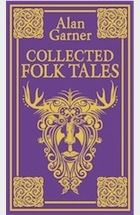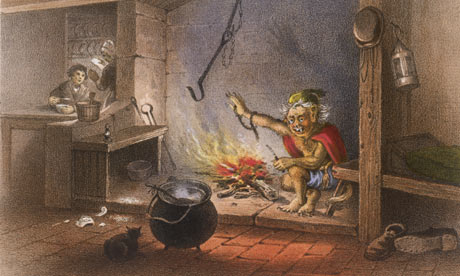An enchanting collection of tales old and new from a writer who is something of a national treasure
Little Folk Goblin by C Burlison. © Mary Evans Picture Library/Alamy
"There was a hill that ate people," begins the first story. Just like that. "Far away, and a long time ago, on a high mountain, without trees for shelter, without body or arms for anything, on spindly legs, ran Great Head," begins another story. We are in the realm of folk tales, where we are told what happened, and we must simply go along with it
 As I read the Collected Folk Tales there was a feeling of happy familiarity from the first, a déjà vu, as if I knew these stories, some of them intimately. My assumption as I read was that I had encountered most of them in other forms and other places (folk tales are told and retold, after all), but then, when I finished reading, I looked at the copyright page, and realised that more than half the stories had been published in 1969 as The Hamish Hamilton Book of Goblins. I read it when I was nine, and reread it often. I could remember it in my local library, remembered taking it off to a quiet corner, remembered how much I had loved it.
As I read the Collected Folk Tales there was a feeling of happy familiarity from the first, a déjà vu, as if I knew these stories, some of them intimately. My assumption as I read was that I had encountered most of them in other forms and other places (folk tales are told and retold, after all), but then, when I finished reading, I looked at the copyright page, and realised that more than half the stories had been published in 1969 as The Hamish Hamilton Book of Goblins. I read it when I was nine, and reread it often. I could remember it in my local library, remembered taking it off to a quiet corner, remembered how much I had loved it.
It is peculiar to encounter a book half of which was assembled up to 40 years after the rest and not to be able to see any obvious difference in the writing or the writer. The prose in the old stories feels as inevitable as the new. The stories are written in a variety of voices, emulating the places the tales came from, but the prose is always spare and hard, not a word wasted, not a word out of place.
Here we have stories from Britain and Ireland and all over the world, retold with assurance. Some of the high points that were not in the original collection include "The Flying Children", a story of lies and sex and supernatural revenge and murder that I first encountered in Neil Philip's Penguin Book of English Folk Tales. It is a story that makes authors want to retell it (I shoehorned it into Sandman). Then there's a tale Garner calls "Iram Biram", which Philip called "The Pear Drum" when he collected it, and which is a curiosity in itself, because it began as a nightmarish Victorian short story by Lucy Clifford called "The New Mother". Garner strips it down to its elements. It's an act of literary ventriloquism that illuminates the oral and folk tradition. Two girls named Blue Eyes and Turkey are tempted by a wild girl to be naughty, with the promise of a gift of a mysterious "pear drum". They are not naughty enough to get the drum, but are still so naughty that their mother leaves, and a new mother, with glass eyes and a wooden tail, takes her place.
Garner goes beyond the original ending, playing with the sound and the meaning of words:
There were no lamps lit, but in the glow of the fire they saw through the window the glitter glitter green glass of a mother's eye. They heard the thump; thump; thump of a wooden tail.
Iram, biram, brendon bo
Where did all the children go?
They went to the east, they went to the west
They went where the cuckoo has its nest.
Iram. Biram. Brendon. Bo.
And the Wild Girl wept.
Garner makes up a poem, and adds the haunting image of the Wild Girl weeping as a way of closing the tale, thus moving it somewhere entirely new, away from Victorian nursery horror and into the realm of the twice-told tale.
Neil Gaiman's full review at The Guardian.
 As I read the Collected Folk Tales there was a feeling of happy familiarity from the first, a déjà vu, as if I knew these stories, some of them intimately. My assumption as I read was that I had encountered most of them in other forms and other places (folk tales are told and retold, after all), but then, when I finished reading, I looked at the copyright page, and realised that more than half the stories had been published in 1969 as The Hamish Hamilton Book of Goblins. I read it when I was nine, and reread it often. I could remember it in my local library, remembered taking it off to a quiet corner, remembered how much I had loved it.
As I read the Collected Folk Tales there was a feeling of happy familiarity from the first, a déjà vu, as if I knew these stories, some of them intimately. My assumption as I read was that I had encountered most of them in other forms and other places (folk tales are told and retold, after all), but then, when I finished reading, I looked at the copyright page, and realised that more than half the stories had been published in 1969 as The Hamish Hamilton Book of Goblins. I read it when I was nine, and reread it often. I could remember it in my local library, remembered taking it off to a quiet corner, remembered how much I had loved it.It is peculiar to encounter a book half of which was assembled up to 40 years after the rest and not to be able to see any obvious difference in the writing or the writer. The prose in the old stories feels as inevitable as the new. The stories are written in a variety of voices, emulating the places the tales came from, but the prose is always spare and hard, not a word wasted, not a word out of place.
Here we have stories from Britain and Ireland and all over the world, retold with assurance. Some of the high points that were not in the original collection include "The Flying Children", a story of lies and sex and supernatural revenge and murder that I first encountered in Neil Philip's Penguin Book of English Folk Tales. It is a story that makes authors want to retell it (I shoehorned it into Sandman). Then there's a tale Garner calls "Iram Biram", which Philip called "The Pear Drum" when he collected it, and which is a curiosity in itself, because it began as a nightmarish Victorian short story by Lucy Clifford called "The New Mother". Garner strips it down to its elements. It's an act of literary ventriloquism that illuminates the oral and folk tradition. Two girls named Blue Eyes and Turkey are tempted by a wild girl to be naughty, with the promise of a gift of a mysterious "pear drum". They are not naughty enough to get the drum, but are still so naughty that their mother leaves, and a new mother, with glass eyes and a wooden tail, takes her place.
Garner goes beyond the original ending, playing with the sound and the meaning of words:
There were no lamps lit, but in the glow of the fire they saw through the window the glitter glitter green glass of a mother's eye. They heard the thump; thump; thump of a wooden tail.
Iram, biram, brendon bo
Where did all the children go?
They went to the east, they went to the west
They went where the cuckoo has its nest.
Iram. Biram. Brendon. Bo.
And the Wild Girl wept.
Garner makes up a poem, and adds the haunting image of the Wild Girl weeping as a way of closing the tale, thus moving it somewhere entirely new, away from Victorian nursery horror and into the realm of the twice-told tale.
Neil Gaiman's full review at The Guardian.

No comments:
Post a Comment